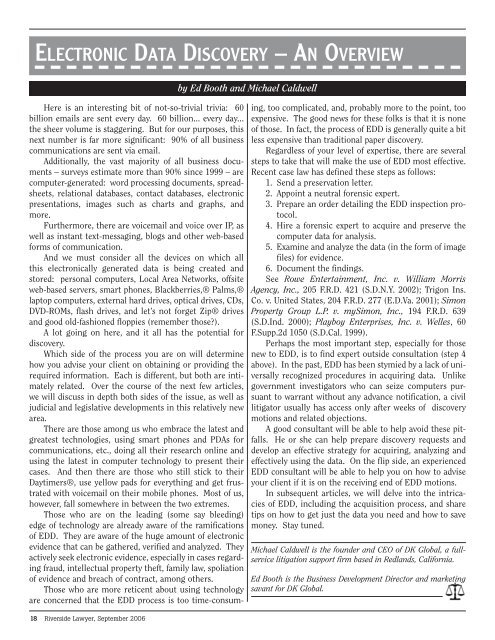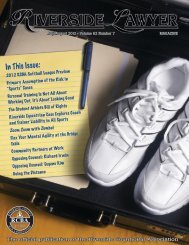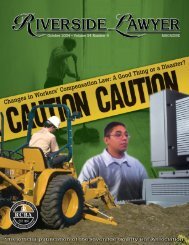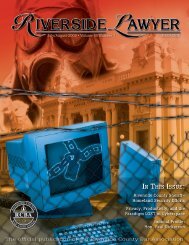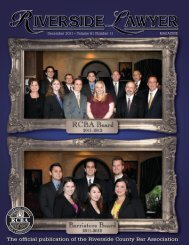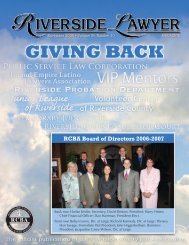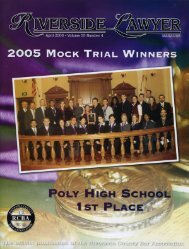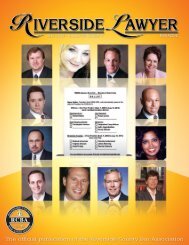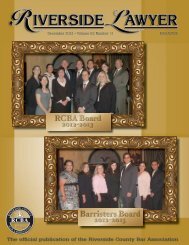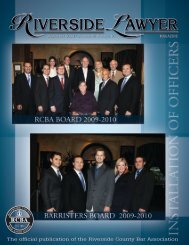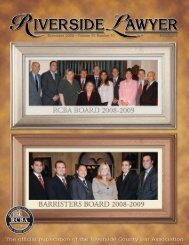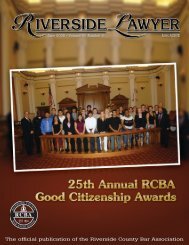THE JOHN GABBERT GALLERY - Riverside County Bar Association
THE JOHN GABBERT GALLERY - Riverside County Bar Association
THE JOHN GABBERT GALLERY - Riverside County Bar Association
Create successful ePaper yourself
Turn your PDF publications into a flip-book with our unique Google optimized e-Paper software.
Electronic Data Discovery – An Overview<br />
Here is an interesting bit of not-so-trivial trivia: 60<br />
billion emails are sent every day. 60 billion... every day...<br />
the sheer volume is staggering. But for our purposes, this<br />
next number is far more significant: 90% of all business<br />
communications are sent via email.<br />
Additionally, the vast majority of all business documents<br />
– surveys estimate more than 90% since 1999 – are<br />
computer-generated: word processing documents, spreadsheets,<br />
relational databases, contact databases, electronic<br />
presentations, images such as charts and graphs, and<br />
more.<br />
Furthermore, there are voicemail and voice over IP, as<br />
well as instant text-messaging, blogs and other web-based<br />
forms of communication.<br />
And we must consider all the devices on which all<br />
this electronically generated data is being created and<br />
stored: personal computers, Local Area Networks, offsite<br />
web-based servers, smart phones, Blackberries,® Palms,®<br />
laptop computers, external hard drives, optical drives, CDs,<br />
DVD-ROMs, flash drives, and let’s not forget Zip® drives<br />
and good old-fashioned floppies (remember those?).<br />
A lot going on here, and it all has the potential for<br />
discovery.<br />
Which side of the process you are on will determine<br />
how you advise your client on obtaining or providing the<br />
required information. Each is different, but both are intimately<br />
related. Over the course of the next few articles,<br />
we will discuss in depth both sides of the issue, as well as<br />
judicial and legislative developments in this relatively new<br />
area.<br />
There are those among us who embrace the latest and<br />
greatest technologies, using smart phones and PDAs for<br />
communications, etc., doing all their research online and<br />
using the latest in computer technology to present their<br />
cases. And then there are those who still stick to their<br />
Daytimers®, use yellow pads for everything and get frustrated<br />
with voicemail on their mobile phones. Most of us,<br />
however, fall somewhere in between the two extremes.<br />
Those who are on the leading (some say bleeding)<br />
edge of technology are already aware of the ramifications<br />
of EDD. They are aware of the huge amount of electronic<br />
evidence that can be gathered, verified and analyzed. They<br />
actively seek electronic evidence, especially in cases regarding<br />
fraud, intellectual property theft, family law, spoliation<br />
of evidence and breach of contract, among others.<br />
Those who are more reticent about using technology<br />
are concerned that the EDD process is too time-consumby<br />
Ed Booth and Michael Caldwell<br />
ing, too complicated, and, probably more to the point, too<br />
expensive. The good news for these folks is that it is none<br />
of those. In fact, the process of EDD is generally quite a bit<br />
less expensive than traditional paper discovery.<br />
Regardless of your level of expertise, there are several<br />
steps to take that will make the use of EDD most effective.<br />
Recent case law has defined these steps as follows:<br />
1. Send a preservation letter.<br />
2. Appoint a neutral forensic expert.<br />
3. Prepare an order detailing the EDD inspection protocol.<br />
4. Hire a forensic expert to acquire and preserve the<br />
computer data for analysis.<br />
5. Examine and analyze the data (in the form of image<br />
files) for evidence.<br />
6. Document the findings.<br />
See Rowe Entertainment, Inc. v. William Morris<br />
Agency, Inc., 205 F.R.D. 421 (S.D.N.Y. 2002); Trigon Ins.<br />
Co. v. United States, 204 F.R.D. 277 (E.D.Va. 2001); Simon<br />
Property Group L.P. v. mySimon, Inc., 194 F.R.D. 639<br />
(S.D.Ind. 2000); Playboy Enterprises, Inc. v. Welles, 60<br />
F.Supp.2d 1050 (S.D.Cal. 1999).<br />
Perhaps the most important step, especially for those<br />
new to EDD, is to find expert outside consultation (step 4<br />
above). In the past, EDD has been stymied by a lack of universally<br />
recognized procedures in acquiring data. Unlike<br />
government investigators who can seize computers pursuant<br />
to warrant without any advance notification, a civil<br />
litigator usually has access only after weeks of discovery<br />
motions and related objections.<br />
A good consultant will be able to help avoid these pitfalls.<br />
He or she can help prepare discovery requests and<br />
develop an effective strategy for acquiring, analyzing and<br />
effectively using the data. On the flip side, an experienced<br />
EDD consultant will be able to help you on how to advise<br />
your client if it is on the receiving end of EDD motions.<br />
In subsequent articles, we will delve into the intricacies<br />
of EDD, including the acquisition process, and share<br />
tips on how to get just the data you need and how to save<br />
money. Stay tuned.<br />
Michael Caldwell is the founder and CEO of DK Global, a fullservice<br />
litigation support firm based in Redlands, California.<br />
Ed Booth is the Business Development Director and marketing<br />
savant for DK Global.<br />
18 <strong>Riverside</strong> Lawyer, September 2006


